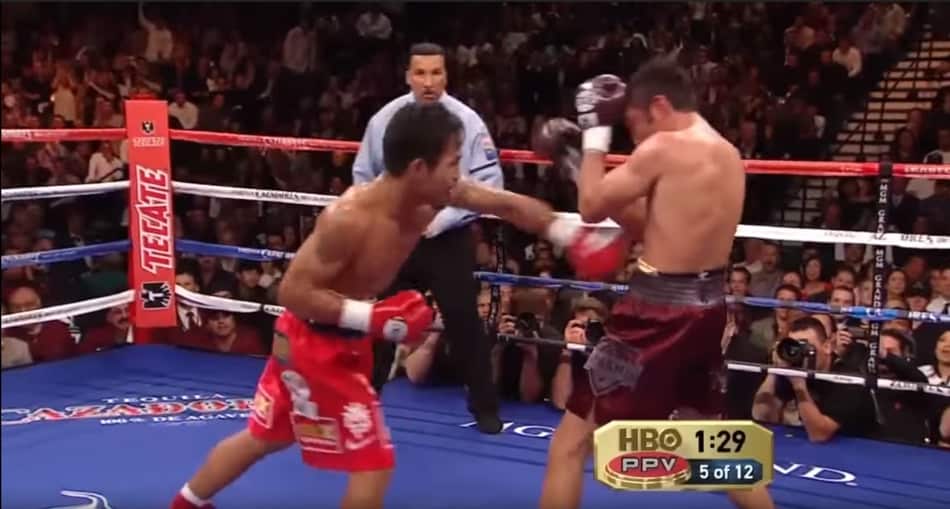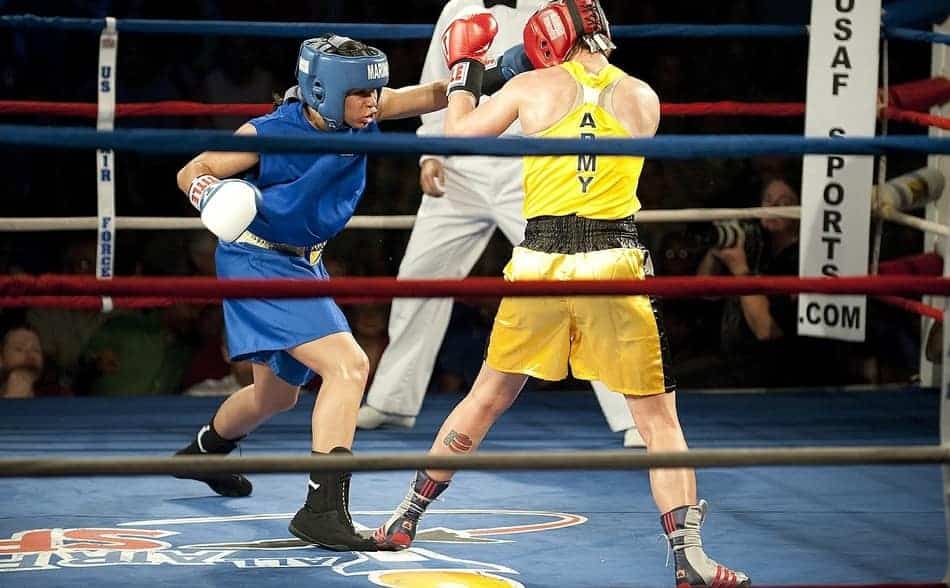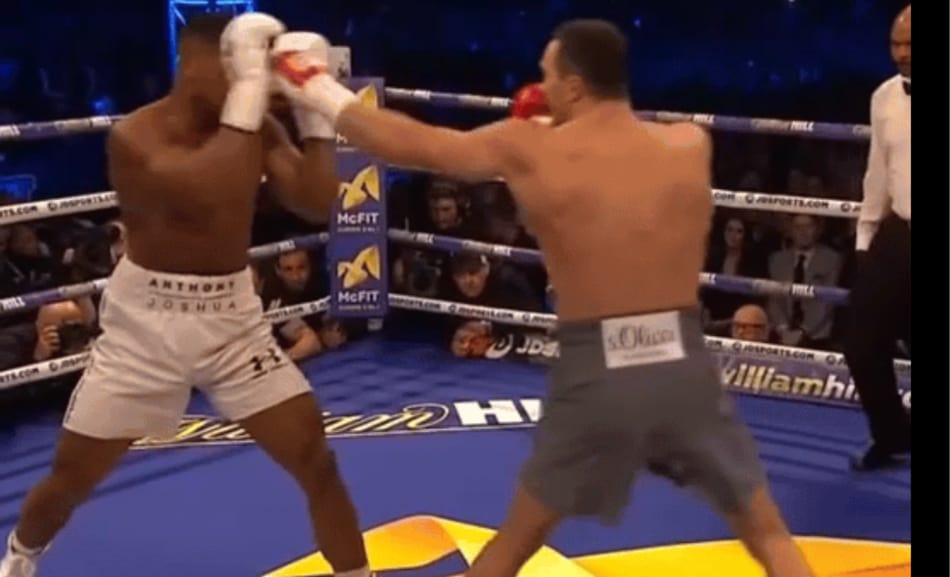
In boxing, to be a southpaw boxer can be really beneficial. That’s because most of the boxers use the orthodox stance and they rarely face southpaws. So they usually aren’t used to fight with southpaws and don’t know how to deal with them. On the other hand, the southpaws are fighting/sparring with orthodox boxers all the time so they know all their tricks.
But to beat an orthodox boxer, you can’t just rely on the experience factor. You also need to know what are the natural advantages that are coming with your stance and how to use them. And this is what you are going to learn in this guide – all the tricks you can use as a southpaw to beat an orthodox boxer. So let’s get started:
What is southpaw boxing stance?
The most commonly used boxing stance is the orthodox one. The boxers who use it place their left hand and left foot in front when fighting. They use their left hand to throw quick but less powerful punches (such as the jab). Their harder shots are coming from their right hand (which is at the rear).
On the other hand, the southpaw fighters, do the complete opposite – their right hand and foot are in front, while their left hand and foot are at the rear.
Usually, the orthodox boxers are right handed and the southpaws are lefties.
Can right-handed person fight in a southpaw stance?
Yes, you definitely can do it. Actually, there are some advantages for the right-handed southpaw boxers. But I don’t recommend doing it, especially if you are a beginner. Because in boxing, when your dominant hand (the hand with which you write) is in front, you will start using it too much, while your weak hand will remain unused.
And that is a disadvantage because you may become too predictable for your opponents. They will know that the only real threat can come from your lead hand. So they will be prepared for it, and you won’t be able to catch them easily.
The other drawback is the lack of power. When your dominant hand is at the rear, you hit harder with it, because of the bigger momentum you can build. And when your stronger hand is in front you are giving up this advantage. That’s why I recommend having your power hand at the rear, especially if you are a beginner.
Do boxers switch stances?
When watching boxing matches, you probably noticed how some boxers switch their stance during the fight. The reason why they do it is to surprise their opponents, to attack them from different angles or also as a defensive maneuver. You can definitely benefit from switching stances, but before starting doing that, first, you need to learn how to defend yourself in both stances (orthodox and southpaw). Because there is no point in switching in a stance where you are vulnerable for punches.
Why do southpaws have an advantage?
Besides the fact that the orthodox boxers haven’t enough experience, fighting against southpaws, there are two more advantages, you can get when fighting someone in the opposite stance:
Outside foot advantage

When fighting against an orthodox boxer, your both lead feet are facing each other. But the boxer who manages to place his lead foot on the outside of the other boxer’s lead foot has an advantage in the exchanges. That’s because when your lead foot is on the outside, your body and head are off the center line, which means that the opponent can’t hit you properly because of the weird angle. Meanwhile, you can land shots with both of your hands.
The other benefit, of placing your lead foot outside, is the mobility. You will be able to move in whenever direction you want – to your left, right, or even behind your opponent, where there is no chance for him to catch you. On the flip side, the other boxer has only one option – to retreat.
In southpaws vs orthodox match, the boxer which foot is on the outside wins the exchanges 8/10 times. So when fighting against an orthodox fighter, you always need to try to get the outside foot advantage. This is probably the most important trick you can use against orthodox fighters.
Remember that the same principle can be used from the orthodox boxer against you. But if you train regularly and use the tricks I will give you in this article, you will be able to outsmart and outbox your opponent even if he is generally more skilled than you.
After a minute we will dive into all the possible ways you can get the outside foot advantage. But first, let’s see which are the other benefits of your stance:
Trapping the lead hand
Besides your lead foot, your lead hand is also facing your opponent’s lead hand. And that is beneficial because you can use it to trap his lead hand, preventing him to throw jabs at you. Or you can push his hand down and land straight left hand over the top – Vasyl Lomachenko style. And again, keep in mind that your opponent may use the same technique against you if you aren’t careful.
Combinations and counters
Everything is different for the southpaw fighters, including their combination and counter punches. All of their shots are coming from angles which the orthodox boxers aren’t expecting. Later in this guide, we will talk about the 10 best punching combination for southpaws and also I will give you 12 effective counter punches, you can use against your orthodox opponents.
So let’s get started!
Footwork tips

The footwork is the most important aspects of boxing. Before you can land punches, first you need to position yourself in the right place. When it comes to a fight between boxers in opposite stances, the footwork is even more crucial. So here are my top tips on footwork for southpaws:
1) Circle to your right
To beat the orthodox fighter, you always need to move. Otherwise, he will get the outside foot advantage and easily outbox you. And don’t think they don’t know about it. Even I (an orthodox boxer) was taught this trick the first time I spar against a southpaw. So what you need to do is to prevent your opponent from getting this advantage.
And you can that by circling to your right during the fight. That will naturally help you to place your front foot on the outside. The other cool thing is that by moving to your right, you are basically running away from the right hand of your opponent (the orthodox boxer’s power hand). That way he won’t be able to catch you with his most powerful punches. And even if he manages to do it, the impact won’t be that great.
Meanwhile, your opponent may try to move to circle to his left, so he can face you. That will make him run into your moneymaker – your left hand.
2) Take the leadfoot advantage
The easiest way to get the outside foot advantage is just to place your foot there. But that doesn’t mean to step in a wider stance, only to get the advantage. That won’t give you an advantage at all. It will only disrupt your balance and make you more vulnerable for punches. That was a mistake I was making at the beginning, which caused me almost a knockdown.
So when trying to step outside your opponent’s lead foot, the distance between your both feet shouldn’t be more than when you are in your normal stance. That means that you need to move your whole body in this direction (not just to step with the front foot). Which isn’t so easy, especially in a fight where both fighters know about this advantage and try to get it. If that’s the case, both boxers will try to step on the outside and eventually no one will get the advantage.
In order to get your foot on the outside, when fighting with a more experienced opponent, you need to do something more creative. Here are the two best (advanced) ways to get the outside foot advantage:
- Throw light punches to the head and then step on the outside– Your goal is just to distract his attention and block his vision. Is much easier to step outside his front foot when he can’t see you.
- Slip a punch and step outside – Make your opponent miss and use the moment when he is off balance to step outside. Then you can land powerful combinations.
And here is how the best of the best southpaws (fighters such as Vasyl Lomachenko and Manny Pacquiao) use these tactics to step outside:
1) Jab – step outside
It’s easy to make a step with the jab. That’s why that’s the easiest way to get the outside foot advantage. Just throw a quick jab to the head of your opponent and step outside while he is focused on the jab. From there you can throw left cross to his head, hooks to a body or to continue jabbing – the options are endless.
2) Slip the jab to the outside – step outside
When fighting against an orthodox boxer, to slip the jab outside means to move your head slightly to your right just to avoid the punch. After that, you can easily get the outside foot advantage. Because your opponent will be off balance so he won’t be able to pivot fast enough so he can face you.
3) Step outside with the cross
That’s more advanced move, used by Vasyl Lomachenko. What you need to do is to go forward when you throw your left cross and to step outside as it lands. To set the punch up, you can start with the jab (similar to the basic boxing combination – jab->cross), then throw the cross and step outside.
4) Step outside with the right hook
The principle here is similar to the previous way. The difference is that is easier to step outside with a right hook then with a left cross because of the pivoting – the natural movement when throwing a right(lead) hook. But to do it correctly, instead of planting your right foot and pivoting, you need to step outside with the hook as you throw it. Then follow make a step with your back foot and position yourself on the outside.
The hook won’t be very powerful, but that’s not your goal. Your goal is to get the outside foot advantage. You can do this when throwing combinations. For example start with a jab, followed by a cross and the throw the hook and step in with it.
5) Fake left cross – step on the outside
The same idea as throwing the cross and stepping outside. But instead of throwing a real punch, you can just fake it and make your opponent react. In the best scenario, he will cover himself up to block the shot. Then you can step on the outside.
Again, you can try using combinations – first, throw a jab then fake the cross and make the step.
6) Fake right hook – step on the outside
Every time you throw a punch, you leave yourself vulnerable. That’s why the feints are so important. You can use them to trick your opponent, without opening yourself.
That’s why faking the right hook and then stepping on the outside of your opponent’s lead foot can be more effective than throwing a real hook.
7) Make your opponent bend over
To do that, you first need to bend over and throw some body shots (even simple jabs can work). After you do it several times, your opponent will start respecting your body punches. Then you need to fake a body shot just to make him bend over so he can block it. At that moment you can easily step on the outside and take outside foot advantage just because the other boxer won’t be able to react quickly enough because of his position.
What to do after you get the outside foot advantage?
When you get your front foot on the outside, all you need to do is to keep it there and land punches. The problem is that your opponent will probably try to escape and to regain the neutral position (neutral position is when nobody has the outside foot advantage).
He may move back or pivot to his right trying to face you again. What you need to do is to chase him – if he moves back, move back with him. If he pivots, pivot with him. And if he tries to enter in a clinch, put your forearms on his face to stop him. Don’t give up your position advantage.
What to do when you don’t have the lead foot advantage?
Like I already mentioned (many times), in order to beat the orthodox boxer, you need to keep your front foot on the outside. But what about when your opponent manages to step outside? What to do then?
When your foot is on the inside, you are in a disadvantageous position. So chances are you won’t be able to beat your opponent from there. That’s why I recommend, first establishing a neutral position and then you can continue your gameplan (taking the outside foot advantage and destroying the other fighter). There are 5 ways you can do it:
1) Use your forearm – Remember that your opponent can use the same tactics to take the outside foot advantage. So for example, if he tries to do it after he slips your jab, you can push his head with your right forearm. That will stop him for a moment. Then you can pivot to your left and regain the neutral position.
2) Headlock – If your opponent is shorter than you, you can do a headlock (grab his head with your right arm). That’s really effective because when you control the head, you control the body also. With the headlock, you can stop your opponent’s attack or disrupt his balance.
3) Use your lead hand to create distance – Stick your right hand in your opponent’s face or chest. Then move backward and create enough distance so he can’t catch you. Anthony Joshua used this technique to stop Joseph Parker’s attack in their fight.
4) Grab your opponent by the waist – Guillermo Rigondeaux, considered for one of the most talented boxers of our time (a southpaw) uses this trick to enter in a clinch when his opponents take the outside foot advantage. All you need to do is to dip down – under the hands of the other boxer and grab him by the waist. Then you can push him back and create distance.
5) Duck under the punch and push with your upper body – The idea here is similar to tip number 4. But now you need to wait for your opponent to throw a punch, to duck under it and to push him back with your body (without grabbing him). That way you will create enough distance and escape the bad position. This technique requires patience and good timing.
Southpaw guard

The guard of every boxer depends on his style. But in general, there are some tips that are applicable for all southpaw fighters.
For example, most southpaws use a little bit, loose guards. Some of them (like Rigondeaux) even keep their hands down. That makes them more mobile, helps them see the punches, move their head quickly and counter more effectively (some southpaws love to counter). Of course, if you want to use such a guard, you need to have proper head movement, precise timing, and good reactions.
Don’t use Philly shell guard – This guard can be really cool when it comes to defense and counterpunching, but it’s not the most effective one when fighting with someone in the opposite stance. It makes you too open for right hooks and overhands. You can see that when watching Floyd Mayweather’s fights against southpaws. He is probably the boxer who uses the Philly shell most effectively, and he has really hard times fighting against southpaws (especially in the first rounds before he figures them out). That’s why I don’t recommend using this guard when fighting against someone in the opposite stance.
Lead hand control

When choosing your guard (the position of your hands), make sure it allows you to trap your opponent’s lead hand. You can do that by extending your arm a little bit forward – don’t keep it right in front of your face. That will help you catch the jabs and control the lead hand of your opponent. And this is another cool thing that comes with the southpaw’s stance. As I already mentioned, your lead hand is facing your opponent’s lead, so you can use that to your advantage. Here’s how:
Trap the lead hand
Just put your hand on your opponent’s glove. That will prevent him from throwing jabs or lead hooks (actually that will prevent him using his lead hand at all), so his only option will be to throw his right hand. And when you know what he is going to do, you will be prepared for it. You will be ready to slip the right hand and then to counter. That is one of the favorite tricks of the southpaw boxers – trapping the lead hand to make the other boxer throw his right, so they can counter it.
Southpaw punching combinations tips
OK, now is time for the most exciting part of the article – the actual punching. Here are the most effective punches and combinations you can use when fighting against an orthodox fighter.
1) Straight left hand
Range: Mid/Long
Your straight left is your best weapon against orthodox boxers so use it often. The jab isn’t so effective, because of your stance – your lead hand is facing the lead hand of your opponent so he can easily parry your jabs. But when it comes to straight left hand – you can use it whenever you want. There is a huge distance between it and the other boxer’s head, so you can build huge momentum when throwing the left cross.
Try to throw if quickly without telegraphing it and try to land it between your opponent’s gloves. If the other boxer is too fast, walk him down first and press him against the ropes where he can’t run away. Then catch him with the left cross. Or wait for him to attack you and then counter him. You can also move your head sideways (rights) with the punch. That way you will move it off the centerline and avoid possible counters.
You can also use the straight left to counter wide punches, for instance, wide right hooks. If both punches (the wide one and the straight one) are thrown in the same time, the straight punch will always land first because of the shorter distance it needs to travel. And also chances are, you will block the wide right hand with your shoulder when landing the straight left. Just wait for your opponent to throw a wide right hand and release your straight left. You will win the exchange every time.
Tip: Always try to get the outside foot advantage when throwing a straight left hand. That way there is almost no chance to be countered.
2) Jab to the head -> Left uppercut to the body
Range: Mid/Long
That’s my favorite southpaw combination. Your left uppercut usually lands on the liver of the other boxer (if it’s thrown accurately). Which can be really devastating. It’s really hard to recover from a powerful shot in the liver. Such punch can knock down your opponent or even end the fight.
When doing that combination you will probably need to make a step forward with the jab (if you are at a long distance). Because your opponent’s body is really far away from your left hand. So make sure you throw a fast jab to his head to block his vision and to mask your step and your uppercut.
3) Right Uppercut -> Left cross
Range: Mid
Another deadly combination. To make it even more unexpected, you can start by faking the left cross, to make your opponent cover himself up. Then throw the right uppercut between his elbows and make his head pop-up. Ater that catch his head with the left cross.
Tip: If you are at a close distance you can throw a left hook instead of a cross.
4) Right hook -> Left cross
Range: Mid/Long
The orthodox boxers aren’t used to the angle from where your hook is coming. That’s why it’s a great way to set up a powerful cross to the head.
5) Right hook to the body -> Left hand to the head
Range: Short/Mid
One of the oldest yet effective boxing tricks – make your opponent think low – come high. Throw a quick right hook to his body and then catch him unexpectedly with the left hand to the head. The left hand can be a cross or a hook, depending on the range between you and the opponent.
6) Left cross the body -> Jab to the head
Range: Mid/Long
The same “low – height” principle. Land a left cross to the stomach or the solar plexus and follow it up with a hard jab to the head. You can start the combination by a fake punch to the head, to make your opponent open his body. And also you can end it with a left hook to the head.
7) 1->2->1 (Jab->Cross->Jab)
Range: Mid/Long
The most effective (and the most simple) combo in boxing – 1-2 (jab-cross). Try to jab over your opponent’s right hand or over his jab if he jabs you at the same time. Use the additional jab to create distance and exit.
8) 1->2->1->4 (Jab->Cross->Jab->Hook)
Range: Mid/Long
Jab – cross followed by another jab plus hook can be a very tricky combo. That’s because by using it you will make your opponent used to the straight punches you throw. He will put his hands in front of his face to block them. Then you will surprise him with the left hook around his guard (which should catch him badly).
9) Multiple hooks to the body -> Uppercut to the head
Range: Short
This combination is most effective when your opponent is pressed against the ropes. What you need to do is to square up, to press him even more and to start landing left and right hooks to his body. Then as he lowers his guard, catch him with a powerful left or right uppercut to the head and exit the exchange.
Counterpunching tips

While the combinations I described above are really effective against more defensive opponents (because by using them you can make the defensive boxers open themselves), the counter punches here are more useful against aggressive boxers. The idea is to make them miss and catch them as they are open.
Here are the 12 best counters you can use as a southpaw when fighting against an orthodox:
Pull counters:
Pulling punches means to lean or step back as your opponent throws a shot. The idea is to get out of the range of the punch, so it can’t hit you. The cool thing about pulling punches is that by doing it you can make your opponent overextend himself. Which can make him lose balance, so your counter will have a bigger impact.
This technique requires a great distance measurement. You need to train it a lot with your sparring partners before starting doing it in a real fight.
1) Pull the jab -> Counter Straight Left
One of the favorite counters of Floyd Mayweather. He really mastered it. To do it correctly, first, you need to bait your opponent to throw a jab. You can do this by throwing your own jab and wait for your opponent to return a jab. Or by leaning forward a little bit. That will create an illusion that you are closer than you actually are.
After the opponent throws his jab, move your head back and make him miss. Then catch him with a counter left cross as he recovers his guard.
2) Lean back on hooks and uppercuts -> Counter Right Hook
Wait for your opponent (or bait him) to throw a hook or an uppercut. Then lean back, just enough to avoid the punch. After that catch him with your own hook.
That counter is really effective against short hooks to the head.
Slip counters:
To slip punches, you need to time them perfectly. And the best way to improve your timing is with a sparring partner. Ask him to throw punches at you with roughly 70% speed and try to slip them. That will really improve your reflexes and timing. After your slipping ability is on point, use the following counters to beat your orthodox opponent:
3) Slip the Jab (inside) -> Right Hook
To slip the jab inside means to move your head to your left (when fighting against an orthodox boxer). After you do it, use that momentum to land a right hook on the head. Throw the hook over your opponent’s shoulder. You can follow it up with a left cross to the head.
4) Slip the jab (outside) -> Left Overhand
This is one of the most devasting counters you can possibly throw. The idea is similar to the counter described above, but this time you need to move your head to your right (outside the left jab) and to land powerful left overhand over the top.
5) Slip the jab (outside) -> Right Uppercut -> Left cross
That is a combination about which we already talk about – right uppercut followed by a left cross to the head. But now it’s even more devastating because now your opponent is more open (because he missed you with his jab).
To do it, as you slip the jab to your right, load the uppercut and throw it under his jab. Then end the combination with a powerful cross.
6) Slip the cross (outside) -> Left Uppercut to the head
That’s an advanced counter, which can really surprise your opponent and even knock him out. Unlike in the previous examples, now you need to slip a cross instead of a jab. The easiest way to do it is to make your opponent throw the cross by trapping his lead hand. Then move your head to your left and throw a hard uppercut right on the chin.
The reason why I said that this is a more advanced counter, is because you need a really good balance and distance measurement to land that uppercut properly.
7) Slip the cross (outside) -> Right Hook
The same thing as slipping a jab INSIDE, – you need to move your head to your left. Then throw the right hook.
8) Slip the cross (inside) -> Left Overhand
When doing that counter, it’s important to land the overhand over your opponent’s right shoulder (you won’t do much damage if you hit him in the shoulder).
9) Duck under the left hook -> Right Hook
Instead of blocking the left hook, try to duck under it. That will make your opponent lose his balance after he misses and it will be easier to drop him with your right hook.
Parry counters:
The parry counters are easiest southpaw counters. That’s because your stance allows you to easily parry shots (especially left-hand punches):
11) Parry the jab – Throw your own jab
All you need to do here is to time your opponent’s jab, to push his glove down with your right hand and to catch him with your own jab. Then you can follow the jab up with a left cross, hook or overhand. Of course, to do it you need a good timing (which actually isn’t so hard to develop. You only need several sparring sessions with an orthodox boxer (who likes to throw his jab).
12) Parry the jab -> Throw a left cross
This is my personal favorite parry counter. It’s a very basic technique but it can be really effective. This time, instead of throwing a jab, after you push your opponent’s glove down, you need to throw a powerful left cross to his head. It’s much more devastating.




Absolutely fantastic stuff! Much appreciated from someone who is trying to learn southpaw tactics
I think you should write something with Boxer expert.com.